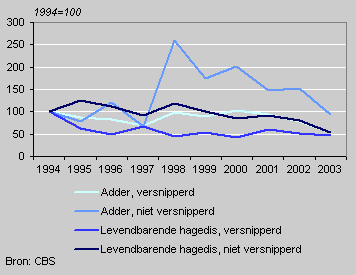Less heath land suitable for adders and lizards

The number of adders in fragmented areas of heath land has fallen by about a third in the last ten years. In larger contiguous areas of heath land the number of adders remained about the same in the same period. The number of viviparous lizards also fell more sharply in fragmented heath land areas than in the non-fragmented areas.
Adders and viviparous lizards on heath land by fragmentation of habitat

Decline in dry areas
The main reason for the decline in the number of reptiles is the fragmentation of the habitat of these creatures and the dehydration of heath land areas as a result of groundwater withdrawal and agricultural drainage activities.
The number of adders have remained quite stable in the wetter areas, but are declining in drier areas. Viviparous lizards are declining in both wet and dry areas, but more so in dry areas.
Adders and viviparous lizards, by dehydration of habitat

Many heath land areas unsuitable for viable populations
One third of the total area of heath land in the Netherlands has become unsuitable to sustain viable adder populations. One fifth is no longer suitable for viviparous lizards. The situation is even worse in the heath land areas of the provinces of Drenthe and Friesland: about 45 percent of the areas of heath land in these provinces will eventually become unsuitable habitat for adders, and more than a quarter will no longer be able to sustain viable viviparous lizard populations.
Reptiles more vulnerable as habitat deteriorates
Compared with a century ago, only one tenth of the total area of heath land now remains in the Netherlands. A large part of what is left has been split up into small areas. Nearly 90 percent of all heath land consists of areas smaller than 10 hectares. Animals which are not very mobile, such as reptiles, suffer from this fragmentation of their habitat.
The smaller a habitat is, the more vulnerable reptiles become with regard to inbreeding, local habitat deterioration and incidental events such as hot dry summers and shortage of food. If such an area of heath land is also isolated from other areas, this only serves to increase the vulnerability, as interaction with neighbouring populations is no longer possible.
Ben Daemen and Annie Zuiderwijk (RAVON)